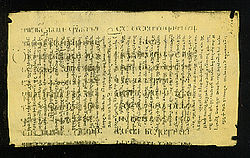palimpsest / PAL-imp-sest / noun
1 : writing material (as a parchment or tablet) used one or more times after earlier writing has been erased2 : something having usually diverse layers or aspects apparent beneath the surface
"Canada, like any country, is a palimpsest, an overlay of classes and generations." (Margaret Atwood, New York Times Book Review, March 10, 1985)
In olden days, writing surfaces were so rare that they were often used more than once. "Palimpsest" originally described an early form of recycling in which an old document was erased to make room for a new one when parchment ran short. Fortunately for modern scholars, the erasing process wasn't completely effective, so the original could often be distinguished under the newer writing. De republica, by Roman statesman and orator Cicero, is one of many documents thus recovered from a palimpsest. Nowadays, the word "palimpsest" can refer not only to such a document but to anything that has multiple layers.
A Georgian palimpsest of the 5th/6th century.
Architects imply palimpsest as a ghost—an image of what once was. In the built environment, this occurs more than we might think. Whenever spaces are shuffled, rebuilt, or remodeled, shadows remain. Tarred rooflines remain on the sides of a building long after the neighboring structure has been demolished; removed stairs leave a mark where the painted wall surface stopped. Dust lines remain from a relocated appliance. Ancient ruins speak volumes of their former wholeness. Palimpsests can inform us, archaeologically, of the realities of the built past.
Example of an architectural palimpsest in downtown Toronto, Ontario, Canada
I like to think of the word in the context of writing -- the layers of meaning just beneath the surface of the words on the paper. And in the context of people, who are what we see but much more beneath.


No comments:
Post a Comment